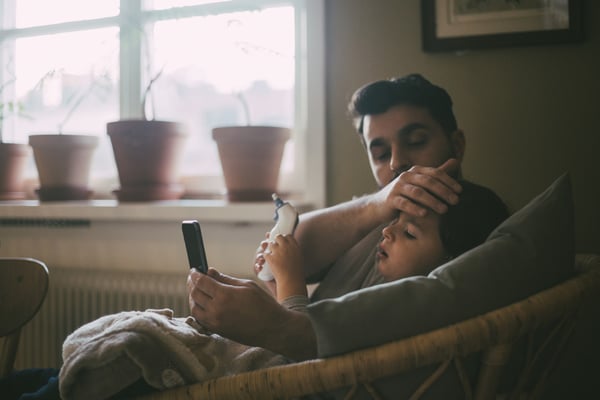As outlined previously, with the pandemic going strong for a year, healthcare professionals are profoundly feeling the weight. Symptoms of PTSD, depression, and burnout are emerging in clinicians and precious clinical hours are getting lost due to the struggles of healthcare workers with their mental health. Attending to this critical issue is part of a larger reform, nevertheless, there is a readily available tool that is underused – and has proven to work for burnout rehabilitation: Online consultations. We have known his story for a few years now and now we pass the microphone to him: Hejko Schlesinger, GP at the Jönköping region, tells us his story of rehabilitation from burnout with digital health.
Hejko Schlesinger has been working as a General Practitioner at the primary care centre Bra Liv nära in the Jönköping Region in Sweden for the past 8 years. A few years back, Hejko was diagnosed with burnout syndrome – the third in his professional time. At the time, the Jönköping Region had recently deployed their virtual clinic Bra Liv nära. Hejko along with the Operations Manager at Bra Liv nära, Ulf Österstad, optimised Hejko’s rehabilitation and return to practice with online consultations.
We spoke with Hejko to learn more about his story and experience: What were the factors that contributed to his burnout? How did digital health support in mitigating these factors? What benefits does he see and how does he perceive online consultations today? How can this be applied to other clinicians in the same state and to other healthcare organisations? Hejko, who currently resides and works in Switzerland, also tells us how Bra Liv nära made it possible for him to continue practising in the Swedish healthcare system remotely. In this interview, we discuss the questions above and more.
Hi Hejko! Where do we find you today?
You find me in Switzerland in Winterthur. I’m working 80% here as a General practitioner and 20% for Bra Liv nära, the virtual clinic of Jönköping Region. Before I was working from Sweden 80% which was 100% for me with Bra Liv nära and it’s in the end, about four years.
To give some context to the discussion, we have been investigating the topic of burnout and the mental health of healthcare professionals lately – particularly in the UK and especially for healthcare professionals in ICU units. It has been 10 months now and a lot of them are reporting quite severe symptoms, consistent with PTSD and suicidal ideation. It’s a really grim image and the point we’re trying to advocate for is that digital is – or can be a tool in that toolbox that provides a solution for them. Could you tell us how digital health helped your rehabilitation from burnout a few years ago?
In the beginning, I went into the Bra Liv nära, because I had burnout – the third actually – and it was not possible for me to work under the pressure that exists in a physical health centre, with all the time pressures and the administrational work. At the same time, the incoming cases were never-ending and there wasn’t enough time for them or a clear structure in the working day.
Bra Liv nära was for me the possibility to give a clear structure to my day. This was really comfortable – patients and for me: They didn’t need to have to drive anywhere, I didn’t either and this played a big role.
Another big advantage for me is that you can work in your own tempo and have all information you need directly in real-time.
In the frame of your recovery, what would you say were the problems that digital health or this platform solved for you? What obstacles were removed working this way?
The most important thing was that, by working from home with online consultations, nobody disturbed me. When I first began with it, I had a room at the medical centre and on the first appointment of 15 minutes, I had been interrupted three times by a nurse knocking at the door asking for help. This problem persisted in the first week so I said that it’s impossible. Then I began working from home. There were no disturbances – the phone was off, you could focus totally on your work, it was quiet. I had my focus time, without being on the edge that somebody would want something more – you only have this singular communication channel with the patient through Bra Liv nära and there were no other open channels so you can focus.
How is the reality after recovering from burnout to a return to normal through online consultations? How do you experience it now?
The interesting thing was moving back to Switzerland, where I had to meet patients physically again. But I said I can’t live without Bra Liv nära, I need to have this little connection point with new technology and new systems. So for me the Thursday and Friday afternoons, when I am working with Bra Liv nära, is slowing down before the weekend. I have my routines, I have been working with it for a lot of years so I know what I am getting.
For me, it’s spending a few hours per week being in Sweden mentally, in the environment that I have been working in the past years and it is fun. With regards to my rehabilitation, my thoughts are always positive when thinking of Bra Liv nära. I’m also relatively free in how I lay out my hours – they are not fixed – and I can rearrange my hours without this resulting in a lack of bookable times or missing patients.
Every person needs a different approach. I wanted to ask you, having the experience, which group of healthcare professionals and with what kind of disposition would be optimal for burnout rehabilitation with online consultations?
If you look at the different specialities in medicine surely the General Practitioners, internal medicine, psychiatrists and psychologists especially, who have no need to physically examine the patient. The most important thing for them is to see the patient and the non-verbal communication; With online consultations, you have this because you have normally a really good video chat so I am convinced that this group will grow and has grown fast in the past few years. Orthopaedics and surgeons maybe not as the main part of their work but I see the possibilities there: for example rehabilitation or a follow-up.
For the personality, you need to be comfortable with working electronically, be open-minded, interested in electronic communications and wanting to develop new possibilities in healthcare.
If someone is in a difficult mental state like these, everything new can feel like such a big thing and it can be reassuring to hear that coming back is not the easiest. However, it can give you that push to try something new and that in itself can help them start ‘swimming again’ or move on.
Exactly! In the beginning, if you have burnout syndrome, you are reduced, you normally have a tendency to self-isolate and with this, you can in some way proceed. In burnout, you are in a situation where you don’t want to meet other people physically, you don’t like big groups of people and you don’t want to be in that situation because you’re afraid of much incoming input. Here, you can have selected input. The fantastic thing with Bra Liv nära and this platform is that we can have discussions between colleagues. So, if you have some questions right now, you can link in the patient with other colleagues sand pull in other specialists based on the needs.
What would it mean for your organisation if you were out longer? If we have, for example, 1,000 healthcare professionals out of work, what does it mean for a healthcare organisation, for the patients, the population?
If you have 1,000 healthcare professionals out of their jobs because of burnout and all the stress we have under the pandemic – but even without, it was a problem even before – there aren’t enough healthcare professionals to keep the system running for the patients. A lot of professionals are going more and deeper into their depression or burnout symptoms because they don’t know what to do, they are staying at home with no social contact because they don’t have a possibility to work remotely.
They can work in a flexible system as we can, with online consultations. It would be horrible for the system if digital health does not become bigger – a much bigger part of the medical system everywhere. The professionals are not using their profession to treat patients. Plus, it’s much better for the organisations, because, working electronically from home, you don’t need an extra room, you don’t need any additional equipment that you need at the primary care centre – all you need is the laptop, yourself, and a good system that’s working so it’s a cheap way for non-invasive medicine to get people back to their work. In the end, it’s way more effective and affordable and the NHS doesn’t have much money.
You are the director of an NHS clinic and you have your colleagues and your subordinates showing burnout and PTSD symptoms in these numbers. You get – as the NHS did – some extra financial support or some extra resources to help them and to provide a treatment service for them. How would you do it? What do you set up?
I tried, when I was in Sweden, to get more people into the online consultations as at least part of their work. So they may be working 40-50% at a health centre physically but more wouldn’t possible. For the rest of that time, they would normally be home with sick leave. However, there they can work online from home – maybe 30-40%. They wouldn’t need to be on sick leave and live on this money which is far less. The best approach is to create a system that is working for the individual because it is an individual thing – no burnout patient looks like another.
Maybe the ones who are deeply into burnout or depression can’t do anything else, but they can maybe work 20% in the virtual clinic for two hours a day. They can even do their therapy with a psychologist in the same network. So from being a professional providing care for patients, for the next half hour, you are the patient and can receive treatment.
That flexibility, not to be fixed in a position or identity the whole day, alternating being a private individual out of practice and a healthcare professional in this environment is a positive thing.


